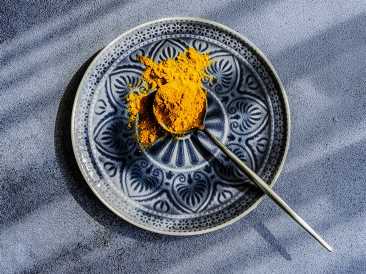
- Turmeric can be just as effective as omeprazole at reducing stomach acid associated with dyspepsia, according to a new study.
- Turmeric is a spice that has been traditionally used as an antacid in Southeast Asia.
- This is the first direct comparison of turmeric’s active ingredient, curcumin, with the medication omeprazole.
In the U.S. and other Western nations, doctors often prescribe omeprazole, a protein-pump inhibitor (PPI), to help reduce acid when a person is experiencing dyspepsia or stomach discomfort.
A new double-blind, placebo controlled trial compared omeprazole’s effectiveness to that of the natural spice turmeric, which has long been used as an antacid in Southeast Asia. The study is the first head-to-head comparison of the two antacid therapies.
The study found that curcumin, the active ingredient in turmeric, is as effective as omeprazole at resolving dyspepsia.
The study conducted in Thailand involved 206 participants. Their age averaged 49.7 years, plus or minus 11.9 years, and 73.4% of them were women.
They were divided into three groups:
- A group of 69 patients were administered two 250 mg capsules of curcumin four times a day, along with one small placebo capsule,
- A second group of 68 patients received one 20 mg omeprazole capsule and two large placebo capsules four times a day,
- A third group of 69 patients received a combination of two 250 mg curcumin capsules four times a day, along with one 20 mg omeprazole capsule.
The trial lasted for 28 days.
20 people in the curcumin group dropped out before the study was completed, 19 in the omeprazole group and 16 in the combined treatment group.
The authors report that curcumin was safe and well-tolerated.
Although both curcumin and omeprazole proved equally effective at reducing dyspepsia, the combination of the two offered no added benefit and was the same as either alone.
The study was published in BMJ Evidence-Based Medicine.
What is dyspepsia?
“The purpose of the stomach is to grind food down into tiny little pieces. And that, in itself, as it gets into your small intestine, makes it much more digestible,” according to gastroenterologist Dr. Rudolph Bedford, who was not involved in the study.
“Dyspepsia is the inability of your stomach to accommodate the things that are coming into it. So it’s a feeling of fullness, discomfort, nausea. Some people may even have heartburn or acid reflux.”
— Dr. Rudolph Bedford
Dr. Bedford said dyspepsia’s cause, or causes, are not entirely understood.
“We think that part of it may be acid, which is why for some people, the omeprazole will work,” he said. It is the only aspect of dyspepsia omeprazole addresses.
Turmeric: a long-time stomach cure
The study’s corresponding author, Dr. Krit Pongpirul, associate professor at the Faculty of Medicine of Chulalongkorn University, explained:
“Turmeric has been used by Thai traditional medicine (TTM) doctors for releasing dyspepsia-like symptoms. It has been included in Thailand’s National List of Herbal Medicines, but good scientific evidence is still essential.”
The use of turmeric dates back nearly 4,000 years, and it has been used as an antacid for much of that time.
“TTM doctors usually assess an individual’s constitutions — earth, water, wind, and fire — before personalizing specific herbs with appropriate flavor,” Dr. Pongpirul detailed.
“Individuals with functional dyspepsia, especially those with excessive gas, are considered [to be of] ‘insufficient wind constitution’ that could be corrected by some herbs with ‘hot flavor’ such as turmeric,” he continued.
He added that explanations of curcumin’s effect often involve its anti-inflammatory properties. Indeed, as Dr. Bedford noted, “I think of turmeric in treating patients with osteoarthritis or other inflammatory processes.”
However, Dr. Pongpirul suggests curcumin may have an effect on the gut microbiome.
Why too little or too much stomach acid is bad
It is not the case that stomach acid is a bad thing in and of itself.
“You do need acid,” pointed out Dr. Bedford, “in order to assimilate calcium, micronutrients, iron, things of that sort. So once you take the acid out, you may have some difficulty in absorbing these micronutrients and calcium for the bones.”
Dr. Pongpirul agreed, noting such adverse effects associated with omeprazole:
“An acidic environment is beneficial not only for the absorption of vitamins and nutrients but also for protecting from some pathogens. PPI may reduce acid too much, so the calcium absorption is affected in the short term, whereas long-term use of PPI would also activate the activity of osteoclasts, which results in bone tissue breakdown.”
“A sufficient level of acid is required to kill several bacteria and viruses that enter the body through the oral route, so the use of PPI is like welcoming these pathogens,” said Dr. Pongpirul.
What’s the best dosing for turmeric?
Dr. Bedford said turmeric would not be a typical day-to-day prescription for his patients and warned that too much of it can bring more harm than good.
“What I tend to see is that patients will take too much of it because they believe that it’s going to help their inflammation. People even use it for their memory and things of that sort,” he pointed out.
“But turmeric, if you take too much of it can in itself cause some indigestion, can cause other inflammatory responses not just within the GI tract, but within the body itself.”
— Dr. Rudolph Bedford
“I’ve seen patients who do develop stomach upset, and in extreme cases may even — believe it or not — develop ulcers from taking too much turmeric because we don’t really have a standardized dosing of it,” Dr. Bedford said.
Indeed, it is the lack of dosing guidelines that prevent Dr. Bedford from prescribing turmeric to his patients. He notes that there is no substantive guidance on turmeric from the U.S. Food and Drug Administration or authoritative medical journals, and the studies he has seen vary widely in their dosing.
Source: Read Full Article
